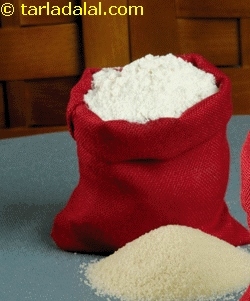sanwa millet flour
Last Updated : Sep 14,2022
Sanwa Millet Flour, Barnyard Millet Flour Glossary |Health Benefits, Nutritional Information + Recipes with Sanwa Millet Flour | Tarladalal.com
Viewed 12632 times

Also known as
Barnyard Millet Flour, Sama
Description of Sanwa Millet Flour, Barnyard Millet Flour
Sanwa Millet is an annual grass cultivated in Japan and southeastern Asia for its edible seeds and for forage; important wildlife food in United States. Sanwa is most commonly red and hard when ripe, and it is usually dried after harvesting for longevity, as the grains are stored whole. The whole grain of sanwa millet may be ground into flour or decorticated before grinding to produce either a fine particle product or flour, which is then used in various traditional foods. The sanwa flour (Barnyard Millet Flour) may be ground coarsely or finely, depending on individual preference and recipe requirement. Sanwa millet is especially valuable as it contains the amino acid methionine, which is lacking in the diets of the poor who live on starchy staples. The long storage capacity makes sanwa millet an important crop in risk-avoidance strategies for poorer farming communities.
How to select
The sanwa flour should be clean, dust free and without any infestations or foul odor. It is better to opt for organic grains, if possible.
Culinary uses
" The sanwa flour is usually made into chappatis or rotis and served with vegetables.
" Sanwa millet is favored by the gluten intolerant and is often cooked as a porridge to be eaten alongside other foods..
" Sanwa flour is made into flatbreads, including thick, leavened dosa and thinner, unleavened pancakes.
" Sanwa grain is malted and the grains are ground. This ground flour is consumed mixed with milk, boiled water or yoghurt.
" In Maharashtra and Gujarat, pancakes are made from sanwa flour.
How to store
Store sanwa flour in an airtight container and keep it in a cool and dry place.
Health benefits
" Sanwa millet flour is commonly eaten with the hull, which retains the majority of the nutrients. The plant is very high in fiber and iron, with a fairly high protein level as well. This makes it well suited to its use as a staple starch.
" The sanwa flour are rich in calcium and antioxidants and all the varieties are gluten-free, an attractive alternative for wheat allergy sufferers.

Soya

Missed out on our mailers?
Our mailers are now online!
View Mailer Archive
Privacy Policy: We never give away your email
REGISTER NOW If you are a new user.
Or Sign In here, if you are an existing member.

If your Gmail or Facebook email id is registered with Tarladalal.com, the accounts will be merged. If the respective id is not registered, a new Tarladalal.com account will be created.
Hi,

Click OK to sign out from tarladalal.
For security reasons (specially on shared computers), proceed to Google and sign out from your Google account.